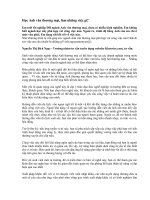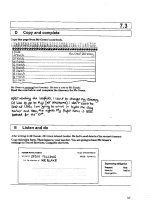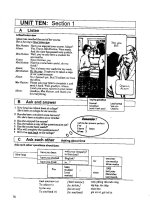economic-statistics2005.pdf
Bạn đang xem bản rút gọn của tài liệu. Xem và tải ngay bản đầy đủ của tài liệu tại đây (467.91 KB, 56 trang )
Economic Statistics
for NOAA
May 2005 – Fourth Edition
U.S. Department of Commerce
National Oceanic and
Atmospheric Administration
2
3
Contents
Contents .......................................................................................................... 3
Forward........................................................................................................... 5
Economic and Social Impacts ........................................................................... 7
Weather and Climate Impacts ......................................................................... 9
Insured Losses............................................................................................... 12
Solar Storms.................................................................................................. 14
El Niño Impacts ............................................................................................ 15
Coastal Storm Impacts .................................................................................. 16
Hurricane Impacts......................................................................................... 17
Harmful Algal Bloom (HAB) Impacts.......................................................... 19
Seafood Impacts............................................................................................ 20
Coastal Pollution and Hazardous Waste Site Impacts................................... 21
Contribution to U.S. Income, Employment, and Output ............................. 23
Fisheries Contributions ................................................................................. 25
Aquaculture................................................................................................... 27
Coastal Contributions.................................................................................... 28
Beach Visitation............................................................................................ 30
Satellites........................................................................................................ 32
Marine Commerce ........................................................................................ 35
Coastal Ocean Observing Systems................................................................ 37
Weather, Climate and Storm Warnings......................................................... 38
Utility Industry.............................................................................................. 41
Agriculture .................................................................................................... 42
General Commerce ....................................................................................... 43
Research........................................................................................................ 45
Defense ......................................................................................................... 46
Sea Grant....................................................................................................... 47
Coastal Ocean Economics, Population, Employment, and Benefits............ 49
Coastal Ocean Economics, Population, Employment ................................... 51
Ocean Economics.......................................................................................... 52
Coastal Benefits ............................................................................................ 54
4
5
Forward
This is the fourth edition to Economic Statistics for NOAA, a compendium of
economic statistics relevant to NOAA’s mission and programs.
It is intended to serve as a common reference to the economic impacts and
benefits of NOAA programs and provide a consistent set of economic statistics
for NOAA management and staff when preparing for Congressional visits and
testimony, budget preparation, speeches, and other external events.
Two criteria were established for inclusion. The first is relevance and
importance to NOAA’s mission and activities. Second is the ability to cite a
credible source in either peer-reviewed or gray literature or correspondence.
Statistics are grouped into three general categories.
• Economic and Social Impacts reflect how natural marine,
atmospheric, and coastal phenomena affect the general public. For
example, weather and climate sensitive industries account for nearly 30
percent of the Nation’s GDP.
• Contributions to U.S. Income, Employment, and Output are
statistics that directly reflect the market value and human uses of
resources impacted by NOAA’s programs. For example, the economic
value added to the national economy by the U.S. commercial fishing
industry was approximately $29 billion in 2002. Other statistics are a
direct measure of the economic benefits of investing in NOAA
programs, such as improvements in El Niño forecasts.
• Coastal Ocean Economics, Population, Employment and Benefits
statistics illustrate the demographic, social, and economic importance
of the Nation’s coastal areas. They also reflect the quantitative
importance of so-called “nonmarket” benefits of coastal resources such
as beaches and recreational boating, which are not directly measured in
dollar terms.
Economic Statistics for NOAA is noteworthy in that it illustrates the economic
importance of NOAA’s programs to the Nation’s economy and public well-
being. This revised edition includes additional statistics on hurricanes, utilities,
and coastal populations.
Economic Statistics for NOAA was prepared by Rodney Weiher, NOAA Chief
Economist and Avery Sen in Program Planning and Integration, with the
assistance and input of staff throughout NOAA.
6
The NOAA Library () serves as the repository for
information in this publication. You may also access most of the sources on the
NOAA Economics & Social Science website’s electronic library
( />).
Questions and comments should be directed to NOAA Chief Economist Dr.
Rodney Weiher by e-mail at
or by phone at (301)
713-3322.
Vice Admiral Conrad C. Lautenbacher Jr. (USN-ret.)
Under Secretary of Commerce for Oceans and Atmosphere
Administrator, National Oceanic and Atmospheric Administration
Washington, DC
April 2005
7
Economic and Social Impacts
8
9
Weather and Climate Impacts
Weather and climate sensitive industries, both directly and indirectly, account
for about one-third of the Nation’s GDP, or $3 trillion, ranging from finance,
insurance, and real estate to services, retail and wholesale trade and
manufacturing.
Cite: Dutton, John A., Opportunities and priorities in a new era for
weather and climate services, Bulletin of the American Meteorological
Society, September 2002, volume 83, no. 9, pp 1303-1311.
Industries directly impacted by weather such as agriculture, construction, energy
distribution, and outdoor recreation account for nearly 10 percent of GDP.
Cite: U.S. Department of Commerce, National Oceanic and Atmospheric
Administration, The economic implications of an El Niño. NOAA
Magazine Online, March 6, 2002, available only online at: http://
www.noaanews.noaa.gov/magazine/stories/mag24.htm
.
Drought is estimated to result in average annual losses to all sectors of the
economy of between $6-8 billion.
Cite: Economic Impacts of Drought and the Benefits of NOAA’s Drought
Forecasting Services, NOAA Magazine, September 17, 2002. Website:
/>.
Although drought does not have major impacts on the overall viability of U.S.
agriculture it does impose costs on regional and local agricultural economies.
The 1999 drought, for example, led to farm net income losses of approximately
$1.35 billion. Areas of the Northeast encountering extreme and severe drought
bore 62 percent of these losses. Farm net income losses were equivalent to only
three percent of the U.S.’s expected net farm income for 1999; however, 25
percent of U.S. harvested cropland and 32 percent of pastureland were affected.
Cite: Economic Impacts of Drought and the Benefits of NOAA’s Drought
Forecasting Services, NOAA Magazine, September 17, 2002. Website:
/>.
Severe fire seasons due to drought and frequent winds can result in billions of
dollars in damages. The Western Fire Season Spring-Summer 2000 resulted in
nearly seven million acres burned and an estimated $2 billion in damage costs
(includes fire suppression).
Cite: Economic Impacts of Drought and the Benefits of NOAA’s Drought
Forecasting Services, NOAA Magazine, September 17, 2002. Website:
10
Average annual damage from tornadoes, hurricanes, and floods is $11.4 billion,
of which:
• hurricanes average $5.1 billion and 20 deaths per year;
• floods account for $5.2 billion, and average over 80 deaths per year,
• tornadoes cause $1.1 billion in damages.
Cite: National Center for Atmospheric Research (NCAR), Environmental
and Societal Impacts Group, and the Atmospheric Policy Program of the
American Meteorological Society, 2001, Extreme Weather Sourcebook
2001: Economic and Other Societal Impacts Related to Hurricanes, Floods,
Tornadoes, Lightning, and Other U.S. Weather Phenomena, National
Center for Atmospheric Research, Boulder, Colo. Available only online
at />.
The costliest U.S. hurricane was in 1926 in Miami, causing $90 billion in
damage (in 2000 dollars). By contrast, Hurricane Andrew (1992) caused $35
billion (in 2000 dollars).
Cite: Jarrell, Jerry D., Landsea, Christopher W., Mayfield, Max, and
Rappaport, Edward N. October 2001 update, The Deadliest, Costliest, and
Most Intense United States Hurricanes from 1900 to 2000 (and Other
Frequently Requested Hurricane Facts), NOAA Technical Memorandum
NWS TPC-1. Hurricane Research Division, Miami, Fl. Available online at:
/>.
In 2002, severe weather caused $5.8 billion in damages which was less than in
2001. Weather-related injuries showed upward trends in 2002, rising to 3,090
from 2,718 in 2001.
Cite: 2002 U.S. Natural Hazard Statistics Report, Summary of Natural
Hazard Statistics for 2001 in the United States, updated Nov. 12, 2003.
Website: /> .
$6 billion annually is lost in economic efficiencies as a result of air traffic
delays, of which 70 percent is attributed to weather.
Cite: 2002 State of the U.S. Airline Industry: A Report on Recent Trends for
U.S. Carriers, Air Transport Association, Washington, D.C., 2002.
Website: />.
Lightning causes $4 to 5 billion in losses each year in the civilian sector.
Cite: Kithil, R., 21st Century Lightning Safety for Facilities & Structures,
Presented at the International Lightning Detection Conference, Tucson,
Ariz., October, 2002.
11
Lightning has consistently been one of the top three causes of weather-related
deaths in the country. It kills between 50 and 70 people and injures hundreds
more each year.
Cite: NWS Office of Climate, Water, and Weather Services. Thirty and 10
year average fatalities for various weather types can be viewed at:
/>.
Lightning costs about $2 billion annually in airline operating costs and
passenger delays.
Cite: Northeast States Emergency Consortium, Wakefield, Mass., 2002.
/>.
The costliest U.S. tornado outbreak caused nearly $1.6 billion in insured losses
on May 3-7, 1999, with the greatest losses in the Oklahoma City, Okla. area.
Cite: Insurance Information Institute, 2002.
.
During 1980-2003, the U.S. sustained 58 weather- or climate-related disasters,
with damages and costs exceeding $1 billion per event. Total inflation adjusted
direct losses from these events were more than $350 billion.
Cite: Billion Dollar U.S. Weather Disasters, 1980-2003. Tom Ross and
Neal Lott, NOAA National Climatic Data Center, 2003. Website:
/>.
Economic costs of snow arise from:
• snow removal (exceeds $2 billion/yr for U.S.),
• road closures that cause lost retail trade, wages, and tax revenue (exceeds $10
billion/day for closures in eastern U.S.),
• flight delays ($3.2 billion annually for U.S. carriers),
• damage to utilities (up to $2 billion per event),
• flooding from snowmelt ($4.3 billion for 1997 floods), and
• cost to agriculture and timber from frost and ice (up to $1.6 billion per ice
storm).
Cite: Adams, R., Houston, L., Weiher, R., The Value of Snow and Snow
Information Services, Report prepared for NOAA's National Operational
Hydrological Remote Sensing Center, August, 2004.
notes
12
Insured Losses
Natural catastrophes (storm, flood, hail, etc.) caused insured losses of USD 15
billion across the globe. In contrast, man-made disasters (explosions, aviation,
accidents, etc.) caused just under USD 2 billion. Natural catastrophes were thus
responsible for significantly more losses than major man-made disasters in
2003. The bulk of the damage from natural catastrophes, $8 billion, was caused
by storms.
Five insured billion-dollar losses in 2003, mounting to $8 billion, were the result
of natural catastrophes in North America. These included events in the
following table:
Costly insured losses in 2003
Event Insured losses
(US dollars)
Victims (dead
and missing)
Country
Tornadoes $3.2 billion 45 US
Hurricane Isabel $1.7 billion 36 US, Canada
Storms and hail $1.6 billion -- US
Cedar fire, urban
forest fires
$1.1 billion 14 US (CA)
Old fire, urban
forest fires
$1.0 billion 4 US(CA)
Cite: Swiss Re sigma preliminary estimates of catastrophe losses.
December 16, 2003.
/>?ReadForm&BM [If the following web link does not work, go to
www.swissre.com
, then click on media centre, news, news releases 2003 (in
left hand column) and then click on 16 Dec 2003 news release.]
Catastrophe bonds are little-known securities through which investors bet on
hurricanes, earthquakes and even terrorist attacks. Insurance companies issue
them to help pay excess claims from such events. Last year, $1.73 billion in
new cat bonds were issued in eight transactions. At the end of 2003, about $4
billion in cat bond debt was outstanding worldwide, about $1.3 billion of it
relating to North Atlantic hurricane risk. “There is no question that this
marketplace could not exist if we did not have sophisticated natural-disaster
models... and the models are just getting better all the time.”
Cite: The New York Times, Storm Chasing on Wall Street, September 19,
2004.
13
Other Extreme Weather (both insured and uninsured):
• The costliest U.S. drought of the past forty years occurred in 1988 and caused
more than $56 billion (in 2000 dollars) of economic losses. More than 5,000
heat-related deaths were also attributed to the heat wave associated with that
event.
• The costliest U.S. flood event occurred in the Midwest during the summer of
1993, resulting in approximately $24 billion in losses (in 2000 dollars) and 48
fatalities.
• The costliest U.S. wildfire of the past forty years occurred in October 1991 in
Oakland, Calif., resulting in more than $3 billion in losses (in 2000 dollars)
and 25 deaths.
• Two of the most costly ice storms in U.S. history occurred during the
1990’s—in the northeast in January 1998 (more than $1.4 billion) and in the
southeast in February 1994 (more than $3 billion).
Cite: Lott, N. and T. Ross, A Climatology of Recent Extreme Weather and
Climate Events, NCDC Technical Report 2000-02, Asheville, N.C.,
NOAA National Climatic Data Center, 2000. Also available online at
/>PUB-A0001
notes
14
Solar Storms
• In January 1997, a geomagnetic storm severely damaged the U.S. Telstar 401
communication satellite, which was valued at $200 million, and left it
inoperable.
• A geomagnetic storm in 1994 damaged two Canadian communication
satellites, which were replaced at a cost of about $400 million.
• A geomagnetic storm in 1989 “blacked out” the power distribution system for
Quebec, Canada, and left 6 million people without electricity for 9 hours at a
cost of $300 million.
• Although these events and their specific impacts were not predicted, current
technology promises to provide real-time warnings and measures to contend
with solar-induced storms.
Cite: Green, Arthur W. and Brown, William, Reducing the Risk from
Geomagnetic Hazards, USDOI and USGS Fact Sheet 177-97. Website:
/>.
notes
15
El Niño Impacts
Overall, the 1997-1998 El Niño is estimated to have had total U.S. economic
impacts on the order of $25 billion.
Cite: Changnon, Stanley A., ed. El Niño 1997-1998; The Climate Event of
the Century, Oxford University Press, 2000.
Property losses were $2.6 billion; crop losses approached $2 billion.
Cite: Weiher, Rodney F. (ed.), Improving El Niño Forecasting: The
Potential Economic Benefits, U.S. Department of Commerce, National
Oceanic and Atmospheric Administration, Office of Policy and Strategic
Planning, Washington, D.C. (2000), p. 18. Also available online at:
/>.
California storm losses in the 1997-98 El Niño were $1.1 billion.
Cite: Changnon, Stanley A., ed. El Niño 1997-1998: The Climate Event of
the Century, Oxford University Press, 2000, p. 22.
notes
16
Coastal Storm Impacts
Coastal storms account for 71 percent of recent U.S. disaster losses annually.
Each event costs roughly $500 million. With 14 events in a year, losses would
total $7 billion per year.
Cite: The H. John Heinz III Center for Science Economics and the
Environment, The Hidden Costs of Coastal Hazards: Implications for Risk
Assessment and Mitigation, Island Press, 2000, Washington, D.C.
notes
17
Hurricane Impacts
The 2004 hurricane season will go down as the most costly season on record in
the U.S. Highlights include: 9 hurricanes/6 tropical storms; 6 of the 9 hurricanes
were major hurricanes (the average number of intense hurricanes is 2); estimated
U.S. damage $42 billion (costliest U.S. hurricane season on record). U.S. deaths
total 59, while deaths outside of the U.S. are estimated at over 3,000.
The spate of hurricanes in 2004 — the largest being Ivan — disrupted
production, damaged pipelines and delayed arrivals of shipments from overseas.
That has added $5 to $6 a barrel to the price of oil, roughly the equivalent of
about 14 cents per gallon for motorists.
Cite: The Atlanta Journal-Constitution, Higher oil prices byproduct of
storms, September 27, 2004.
Hurricanes Charley and Ivan are the second and third costliest U.S. hurricanes
on record, $14 and $13 billion, respectively.
Cite: The National Hurricane Center Web site
/>
Costliest hurricane seasons:
2004: ~$42 billion in U.S. damage
1992: ~$35 billion in U.S. damage (adjusted for inflation, 2000 values)
1989: ~$10.6 billion in U.S. damage
Cite: The National Hurricane Center Web site
/>
Since 1900, hurricanes and tropical storms making landfall on the U.S. Gulf
Coast have caused more than 9,000 deaths and more than $100 billion in
damages (adjusted to 2004 dollars) to homes and property.
Cite: NOAA,Atlantic Oceanographic and Meteorological Laboratory,
Hurricane Research Division. Located at
/>
Some key economic impacts of Hurricane Isabel on the Washington DC MSA
area were:
• Two million lost riders to Metro with a $2.6 million loss in revenue.
• 257,443 Federal Government non-essential DC employees losing 2 days of
employment with a $147.4 million loss in revenue.
• 530,000 lost customers to PEPCO and 40 million in revenue loss.
• 1.3 million Private/Non-Governmental DC employees losing 2 days of
18
employment and $485.4 million in revenue loss.
Cite: Margaret Fowke, Key Economic Impacts of Hurricane Isabel, Office
of Strategic Planning and Policy, NWS/NOAA, November 2003. Copies
available from NOAA Central Library, Silver Spring, Maryland. Website:
.
notes
19
Harmful Algal Bloom (HAB) Impacts
Economic impact of HABs in United States average annually $49 million but
individual outbreaks can cause economic damage that exceeds the annual
average—outbreaks in Chesapeake Bay (1997) cost the Maryland seafood and
recreational fishing industries almost $50 million in just a few months.
Total public health impacts due to shellfish poisoning from HABs averaged $22
million over a six-year interval from 1987-1992.
Commercial fishery impacts from HABs, including wild harvest and aquaculture
losses, average $18 million per year.
Cite: Hoagland, D.M. Anderson, Y. Kaoru and A.W. White. August 2002.
The economic effects of harmful algal blooms in the United States:
estimates, assessment issues, and information needs. Estuaries 25 (4b): 819-
837.
notes
20
Seafood Impacts
Human sickness and death from tainted seafood resulted in lost wages, medical
treatment, and investigation averaging $22 million per year.
Cite: Anderson, D.M.; Hoagland, P.; Kaoru, Y.; White, A.W.; Estimated
Annual Economic Impacts from Harmful Algal Bloom (HABs) in theUnited
States, Technical Report WHOI-2000-11 Woods Hole Oceanographic
Institute, Woods Hole, Mass., p. 5.
notes
21
Coastal Pollution and Hazardous Waste Site Impacts
More than 700 coastal hazardous waste sites have contaminated sediments in
our Nation’s estuaries that reduce the economic and ecological productivity of
coastal resources.
Cite: Coastal Hazardous Waste Site Review, NOAA Office of Response
and Restoration, NOAA, 1999.
Polluted runoff caused over 16,000 beach closings and swimming advisories in
2001.
Cite: Testing the Waters 1999: A Guide to Water Quality at Vacation
Beaches, Natural Resources Defense Council (NRDC), July 1999, Table 3,
“Sources of Beachwater Pollution.” 2002 and August 2003 version is at
/>
NOAA has successfully recovered compensation for restoration at over 110
hazardous waste and oil spill sites around the Nation.
Cite: Office of Response and Restoration, NOAA Ocean Service, Policy
Working Paper 02-1, May 2002.
Since 1990, NOAA has recovered over $300 million for restoration of coastal
and marine resources injured from chemical releases and oil spills.
Cite: Reversing the Tide: Restoring Our Nation’s Coastal and Marine
Environment, NOAA Damage Assessment and Restoration Program, 2002
and 2003.
Pollution has rendered 44 percent of tested US estuaries and 12 percent of ocean
shoreline waters unfit for uses such as swimming, fishing, or supporting aquatic
life.
Cite: Health of the Oceans Report 2002, The Ocean Conservancy,
p.
44.
notes
22
23
Contribution to U.S.
Income, Employment,
and Output
24
25
Fisheries Contributions
Commercial landings by U.S. fishermen in 2003 were 4.3 million metric tons
valued at $3.3 billion.
Cite: Fisheries of the United States, 2003,
/>
U.S. exports of edible fishery products in 2003 were 2.4 billion pounds, valued
at $3.27 billion; total U.S. exports of fishery products (edible and non-edible) in
2003 was valued at $12 billion. The U.S. total value of imported fishery
products was $21.3 billion in 2003. Seafood imports totaled 4.9 billion pounds
in 2003 and were valued at $11.1 billion.
Cite: Fisheries of the United States, Foreign Trade Section 2003, p.60
/>
The value added to gross domestic product (GDP) by the commercial fishing
industry was $31.5 billion in 2003; the value added by the recreational fishing
industry to GDP was $12 billion in 2003.
Cite: Fisheries of the United States, 2003,
/>
Nationwide, anglers spent $14.6 billion on marine recreational fishing in 2000,
which generated over $30.5 billion in sales, $12 billion in income and supported
nearly 350,000 jobs.
Cite: Steinback, Scott, Brad Gentner, and Jeremy Castle. 2004. The
economic importance of marine angler expenditures in the United States.
NOAA Prof. Paper NMFS 2, 169 p.
U.S. consumers ate an estimated 16.3 pounds of seafood per capita in 2003, 0.7
pounds more than in 2002. The United States is the third largest consumer of
seafood in the world.
Cite: Fisheries of the United States, Per Capita Section, 2003, p. 84
/>
Approximately 67,500 people were employed in the seafood processing and
wholesale sectors in 2003.
Cite: Fisheries of the United States, 2003, Employment, Crafts and Plant
Section, p. 93, />









